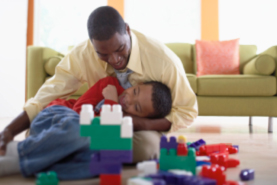Category — 3.1 The “T” Professionals
The “T” Professionals
Therapists: Art, Play, Movement
Art Therapist
Art therapists have a deep understanding of child development, art, and psychotherapy. They undergo extensive training and have to work under the supervision of a licensed psychologist before they can practice on their own. They work with children and adults who have been through trauma, who have trouble relating to others, or who have trouble expressing themselves through conventional methods. Art therapists work with the following groups of children:
- Children with autism;
- Children who have been abused;
- Children who have been neglected;
- Children who are chronically ill, especially children who have cancer;
- Children who have been through a traumatic experience and who have PTSD (see full Glossary);
- Children who have mental illness, such as an anxiety or mood disorder;
In art therapy, children are encouraged to express themselves through art. They may express their feelings, sadness and frustration through:
- Drawing;
- Painting (Fig. 1);
- Playing with sand;
- Playing with play dough;
- Playing with clay.
Figure 1. Painting
Some children may not be able to express themselves through language. Art therapists help these children express themselves and their emotions through art. Slowly, children can sometimes start to express themselves verbally, through language. Art therapists help children grow in all areas of development, including cognition and the social/emotional domain.
For more information about art therapy, please visit the following website.
Play Therapist
Play therapists have a degree in professional psychology, and specialize in play therapy. They have a deep understanding of child development and psychotherapy. They undergo extensive training and have to work under the supervision of a licensed psychologist before they can practice on their own. They work with children who have been through trauma, who have trouble relating to others, or who have trouble expressing themselves through conventional methods. Play therapists work with the following groups of children:
- Children with autism;
- Children who have been abused;
- Children who have been neglected;
- Children who are chronically ill, especially children who have cancer;
- Children who have been through a traumatic experience and who have PTSD (see full Glossary);
- Children who have mental illness, such as an anxiety or mood disorder;
- Children dealing with the loss of a parent;
- Children who have attachment difficulties.
In play therapy, children are encouraged to express themselves through play. The clinic of a play therapist contains a lot of toys and games that children can play with. Some of these are:
- Dolls;
- Pretend play materials;
- Art materials, such as coloring pencils and crayons;
- Puzzles;
- Blocks and Legos (Fig. 2);
- Board and card games.
Figure 2. Playing with blocks and legos
Play therapy can be very useful with children who have difficulty expressing themselves or who are unwilling to express themselves. Play comes naturally to most children. Play activities can help many children open up. All developmental areas can be reached and developed through play therapy. Some of the goals of play therapy are:
- Learning how to express feelings in socially appropriate ways;
- Learning how to manage anger and frustration;
- Learning how to handle the loss of a parent;
- Learning how to relate to others;
- Learning how to be self-confident;
- Learning how to trust adults (this is very important for children who may have been traumatized by adults);
For more information about play therapy, please visit this website.
Movement Therapist
Movement and dance therapists have a deep understanding of child development and psychotherapy. They have extensive training and have to work under the supervision of a licensed psychologist before they can practice on their own. Movement and dance therapy is based on the idea that the body, mind and soul are interrelated (Fig. 3). Therefore, helping a child move and understand his or her body will lead to the healing of the mind and soul as well. Movement and dance therapists work with children who have been through trauma, who have trouble relating to others, or who have trouble expressing themselves through conventional methods. Movement and dance therapists work with the following groups of children:
- Children with autism;
- Children who have been abused;
- Children who have been neglected;
- Children who have mental illness, such as an anxiety or mood disorder;
- Children dealing with the loss of a parent;
- Children who have attachment difficulties;
- Children who have been through a traumatic event, such as witnessing violence.
Figure 3. Dancing
In dance and movement therapy, children learn how to grow in all developmental areas through movement and dance. Through body movement, children learn how to appreciate and understand their bodies, which a leads to understanding of the mind and soul. This leads to growth in all developmental domains.
For more information about dance and movement therapy, please visit this website.
see References
August 27, 2011 No Comments


